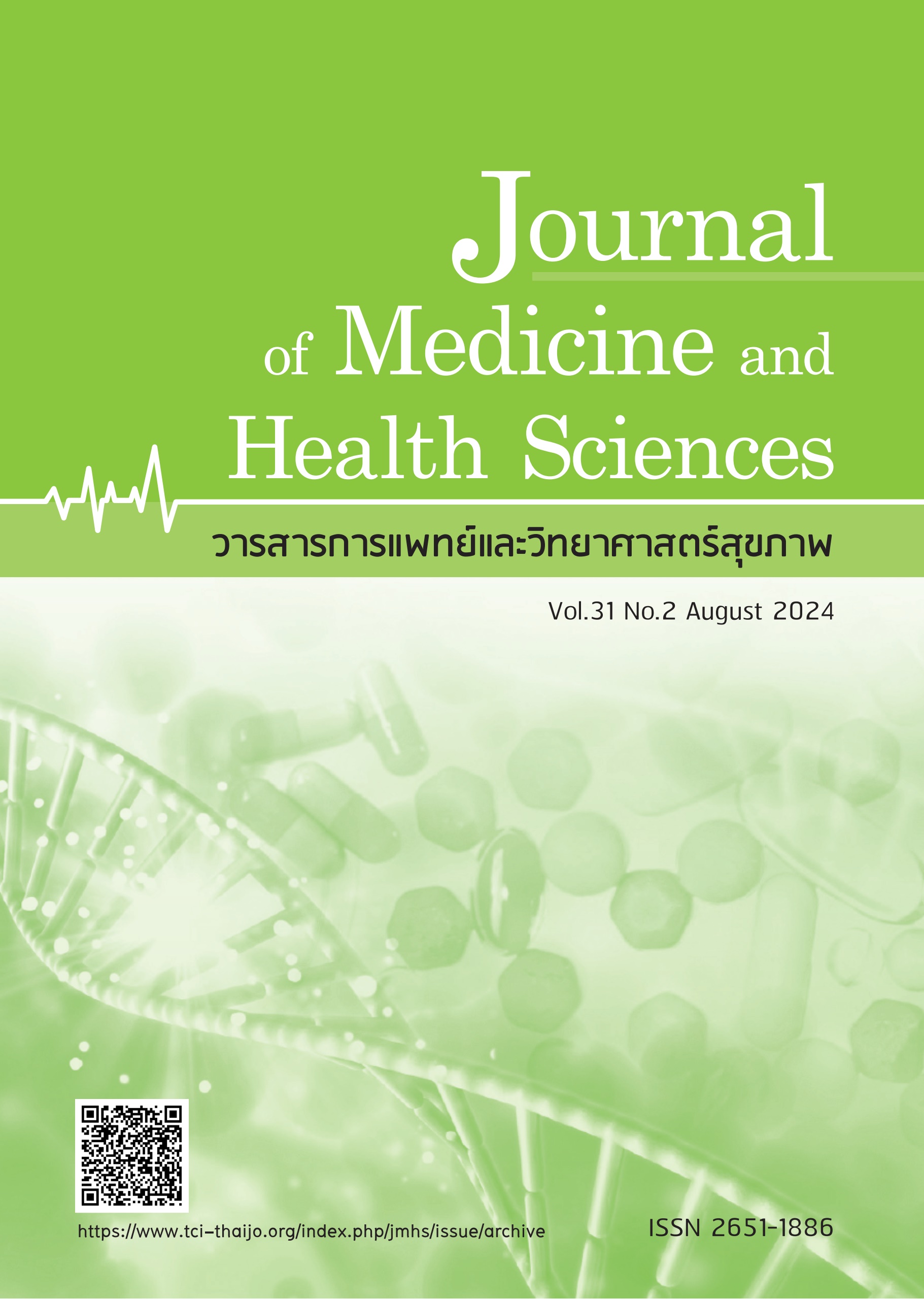Effects of innovation device on the recovery of upper limb movement and function: A pilot study in stroke patients
Keywords:
Cerebrovascular Disease, Rehabilitation, Innovation device, Fugl-Meyer Assessment, Action Research Arm TestAbstract
The objective of this research was to investigate the effects of an innovative device on the rehabilitation of movement and function in the upper limbs of stroke patients at the Department of Physical Medicine and Rehabilitation, HRH Princess Maha Chakri Sirindhorn Medical Center. This study employed a one-group pretest-posttest design, utilizing purposive sampling with criteria-based selection of participants, followed by simple random sampling. The rehabilitation intervention involved using the innovation device developed by Pun-apai N. et al. [12] This device was administered for 1 hour per session, 3 times a week, over a period of 4 weeks. The research findings indicated that among the 10 patients, 6 were male and 4 were female, with an average age of 61.80±16.50 years. The average duration of stroke among the participants was 4.9±1.728 months. The results of comparing data before and after using the innovation device alongside traditional rehabilitation methods indicate that the Fugl-Meyer Assessment scores for upper limb showed a statistically significant increase. Specifically, the average score and standard deviation before using the innovation were 79±16.181, and after using the innovation, they were 98.50±15.582, with a statistically significant increase at p<0.05. The Action Research Arm Test revealed that before using the innovation device, the average score and standard deviation were 17.30±16.310. After using the innovation, the average score and standard deviation were 25.20±19.759, with a statistically significant increase at p<0.05. Proximal muscle strength of upper limb also improved, with average scores and standard deviations before the innovation device being 8.00±2.867, and after the innovation, 9.80±3.615 and distal muscle strength of upper limb, the average scores and standard deviations before the innovation were 5.60±3.950, and after the innovation, 7.40±4.789. It was found that there was a statistically significant increase in the range of motion p<0.05 for shoulder flexion and abduction, as well as elbow flexion. These findings support the benefits of innovation device in the rehabilitation of movement and function in the upper limbs of stroke patients.
References
Feigin VL, Brainin M, Norrving B, et al. World Stroke Organization (WSO): Global stroke fact sheet. Int J Stroke. 2022;17(1):18-29.
Tiamkao S. Incidence of stroke in Thailand. Thai J Neurology. 2023;39(2):39-46.
Pajareya K, editor. Rehabilitation of stroke patients. Bangkok: Medical Education Technology Center, Faculty of Medicine Siriraj Hospital, Mahidol University; 2003.
Rattanachaiyanont M, Tantawichien T, Chierakul N, et al. Contemporary medicine: Medical science advances in harmony to improve the quality of life. 2nd ed. Bangkok: P.A. Living; 2009.
Housman SJ, Scott KM, Reinkensmeyer DJ. A randomized controlled trial of gravity-supported, computer-enhanced arm exercise for individuals with severe hemiparesis. Neurorehabil Neural Repair. 2009;23(5):505-14. Epub 2009 Feb 23.
Péter O, Fazekas G, Zsiga K, et al. Robot-mediated upper limb physiotherapy: review and recommendations for future clinical trials. Int J Rehabil Res. 2011;34(3):196-202.
Colomer C, Baldoví A, Torromé S, et al. Efficacy of Armeo® Spring during the chronic phase of stroke. Study in mild to moderate cases of hemiparesis. Neurologia. 2013;28(5):261-7. Epub 2012 Jun 23.
Keeling AB, Piitz M, Semrau JA, et al. Robot enhanced stroke therapy optimizes rehabilitation: a pilot study. J Neuroeng Rehabil. 2021;18(1):10.
Dehem S, Gilliaux M, Stoquart G, et al. Effectiveness of upper-limb robotic-assisted therapy in the early rehabilitation phase after stroke: a single-blind, randomised, controlled trial. Ann Phys Rehabil Med. 2019;62(5):313-20. Epub 2019 Apr 24.
Patel J, Fluet G, Qiu Q, et al. Intensive virtual reality and robotic based upper limb training compared to usual care and associated cortical reorganization in the acute and early sub-acute periods post-stroke: a feasibility study. J Neuroeng Rehabil. 2019;16(1):92.
Carpinella I, Lencioni T, Bowman T, et al. Effects of robot therapy on upper body kinematics and arm function in persons post stroke: a pilot randomized controlled trial. J Neuroeng Rehabil. 2020;17(1):10.
Phunapai N, Aramrussameekul W, Limboonruang T, et al. Research and development of innovations to rehabilitate arm functionality in elderly individuals and stroke patients with muscle weakness. SWU.JST [Internet]. 2024 Apr 30 [cited 2024 Aug 29];16(31):1-16, Article 254057. Available from: https://ph02.tci-thaijo.org/index.php/swujournal/article/view/254057
Gladstone DJ, Danells CJ, Black SE. The fugl-meyer assessment of motor recovery after stroke: a critical review of its measurement properties. Neurorehabil Neural Repair. 2002;16(3):232-40.
Yozbatiran N, Der-Yeghiaian L, Cramer SC. A standardized approach to performing the action research arm test. Neurorehabil Neural Repair. 2008;22(1):78-90. Epub 2007 Aug 17.
Singh N, Saini M, Kumar N, et al. Evidence of neuroplasticity with robotic hand exoskeleton for post-stroke rehabilitation: a randomized controlled trial. J Neuroeng Rehabil. 2021;18(1):76.
Sale P, Franceschini M, Mazzoleni S, et al. Effects of upper limb robot-assisted therapy on motor recovery in subacute stroke patients. J Neuroeng Rehabil. 2014;11:104.
Downloads
Published
How to Cite
Issue
Section
License
Copyright (c) 2024 Journal of Medicine and Health Sciences

This work is licensed under a Creative Commons Attribution-NonCommercial-NoDerivatives 4.0 International License.



